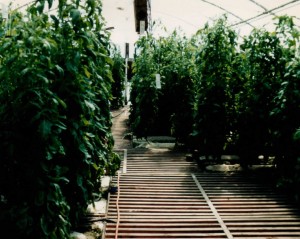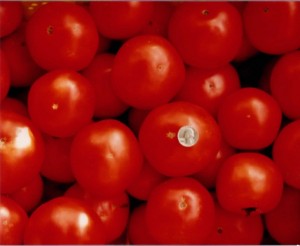There are many reasons for choosing iAVs as a food production strategy. Broadly speaking, iAVs is simpler to build and easier to use. It also requires few resources and has less of an impact on the environment.
- More food with FAR LESS water use.
- More food from LESS land area (and without soil).
- More food in less time (faster growth rates from both crops).
- More profitable with higher quality and greater yield rates.
- Less energy use (electric only, or even just manual labor).
- Less mechanical equipment (or even none in LDC context).
- Less technological equipment (or potentially none at all).
- Less food miles (local food production is both fresher and cheaper).
- NO pollution of the environment (water, land or atmosphere).
- NO chemical fertilizer use. 100% Organic nutrients.
- NO herbicides and NO pesticides.
- NO soil erosion, degradation or run-off pollution.
Advantages and Benefits of the iAVs technique include:
- Reliable, continuous year-round production of high-quality food products with MINIMAL water consumption.
- Comprehensive conservation of nutrient resources through intensive recycling and reuse of ‘waste’ materials and byproducts.
- Conservation of and/or expansion of productive land resources (even to roof-tops) through intensive cultivation and reduction of pressures on over-exploit traditional agricultural lands.
- Extremely advantageous in regions with extreme climate variability and/or soil conditions that are unsuitable for use by traditional agricultural exploitation.
Benefits of iAVs aquaculture and vegetable production include:
- Maximal conservation of and productivity from available water resources and of nutrients in sustainable food production.
- Exceptionally intensive simultaneous production of fish protein and high quality ‘organic’ fruit and/or vegetable crops (virtually any species).
- Reduction of both operating and environmental costs relative to either cultural subsystem operated in isolation:
- Water consumption in an integrated aqua-vegeculture system amounts to 1 percent (or less) of that required in pond culture to produce equivalent tilapia yields.
- Such low-water-use symbiotic systems are applicable to the needs of arid or semi-arid regions where fish and fresh vegetables are in high demand and also in proximity to urban population centers.
- Organic vine-ripened, pesticide-free produce and “fresh-daily” fish can derive premium prices, particularly during winter months in urban areas.
- Consistent, highly-intensive and cost efficient simultaneous production of multiple high-value crops can be exceptionally profitable under effective management of appropriate facilities.
(BELOW) REPEATED FOR EMPHASIS
▪ The absence of any evidence or suggestion to the contrary means that iAVs is, by far and away, THE most water-use efficient agricultural ‘system’ (methodology) as yet devised.
- In terms of fish production, iAVs is 100 (or greater) times more water use efficient than is pond culture, with the vegetable production effectively ‘free’ in terms of water use.
- Alternatively stated, the vegetable crop productivity with iAVs is from 100 to 1000 times more efficient in terms of water use than traditional field agriculture, with the fish production effectively for ‘free’ in water use terms.
- The combined outputs of iAVs are at least 1000 times more efficient in terms of water use per caloric yield rate (food, nutritional value produced).
Basic principles of iAVs (partial description. See other postings for further detail):
- Dissolved and suspended organic materials accumulate rapidly in intensive aquaculture production systems and these must be continuously removed to achieve efficient fish production.
- Biofilters (sand beds, soil organisms and vegetable crops) are intermittently irrigated (and drained) with nutrient-laden fish tank ‘waste’ water and are referred to as “reciprocating biofilters” (RBF).
- Reciprocating biofilters provide uniform distribution of nutrient-laden water within the filtration medium during the flood cycle, and improved aeration from a complete soil atmospheric exchange during each dewatering, which benefits both nitrifying (and other) soil bacteria and plant roots (nutrient assimilation and growth rate).
- All previously attempted (and most current) integrated fish production systems aggressively remove the suspended solid waste fractions from the water column through sedimentation and/or screening in clarifiers prior to plant application (often in several stages, and at great expense, with risk(s) of failure and constant attention and effort) The mechanical removal of the solid waste fraction from the water volume by sand biofilters in iAVs is highly effective and provides sufficient residual nutrients (all required elements and forms) for excellent plant nutrition (rapid growth rates). Commercially viable, acceptable fruit yields have only been achieved in prior (non-iAVs) ‘systems’ through substantial supplementation of externally sourced plant nutrients (and often with frequent water replacement regiments).
- Aqueous nitrate (et al.) concentrations in recirculating aquaculture water can be effectively regulated when fish and vegetable production are linked via reciprocating biofilters and the nutrient(s) input rates are in relative balance with assimilation (growth) rates.
- Tomatoes (et al) may assimilate nitrogen in organic amino acid forms. In 1950 Gosh and Burris (Utilization of Nitrogenous Compounds by Plants. Soil Science. Vol. 70: 187-203) found that tomatoes utilize alanine, glutamic acid, histidine, and leucine as effectively as inorganic nitrogen sources. This ‘saves’ the plant(s) substantial metabolic energy that can then be re-directed to growth (yield).
- Research to determine the optimum ratio of fish tank to biofilter volume (and fish ‘wastes’ to plant biomass) on fish growth rate and water quality influences have found that stocking density of fish and (to) plant number (and types) can be varied (within limits) depending on the operator’s desired goal. The component biometric and/or volumetric ratios of a system may be manipulated to favor either the fish or the vegetable production according to local market trends, valuation or dietary need. Fish stocking density and feeding rates are adjusted periodically to optimize water quality as influenced by plant growth (assimilation) rate(s).
ABOVE: Tomato vines, 2.4 meters tall at 3 months from transplant, in iAVs research (ratio study) greenhouse (NCSU, Raleigh, Fall 1988). @ Yield 6.8 kg/plt = 109 kg m-2 yr -1 (non-optimized). In this photo, the associated 0.5 m3 fish tanks are directly below the wooden grate walk-way (Individual grates open for access when needed, yet feeding, monitoring and sampling are accomplished through the gaps between slats)
ABOVE: Vine-ripened “Organic” tomatoes harvested from above vines w/ 90% as USDA Grade No. 1. US quarter (coin) included for scale. Tomato was specfically chosen in research studies as a valued representative of a high nutrient demand species, especially wrt micronutrients including the metals. (unlike the leaf crops such as lettuces and other greens which are typically calorie negative for humans).
- Other vegetable crops grown in iAVs: basil, beet, bush bean, carrot, chives, cucumber, lettuces, peppers (bell, cheyenne, jalapeño), spinach, and winged bean.
- Closely related species include: chard, eggplant, melons (various), peas, snow peas, squashes and gourds.
- Likely productive candidates include: the Brassica family (broccoli, Brussels sprouts, cabbage, cauliflower and mustard), achenes such as strawberry, and most of the culinary and medical herbs.
- Other potential crops include flowers (particularly beneficial-attractants and pest-repellent spp.) and even seedlings for reforestation, erosion and/or dune stabilization efforts.
-o0o-


 Creative Commons Attribution-NoDerivs
Creative Commons Attribution-NoDerivs